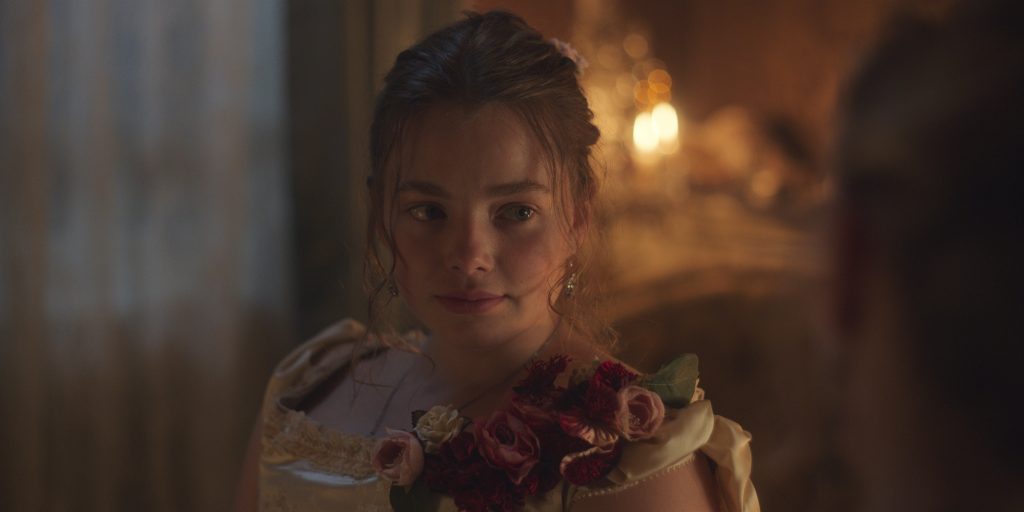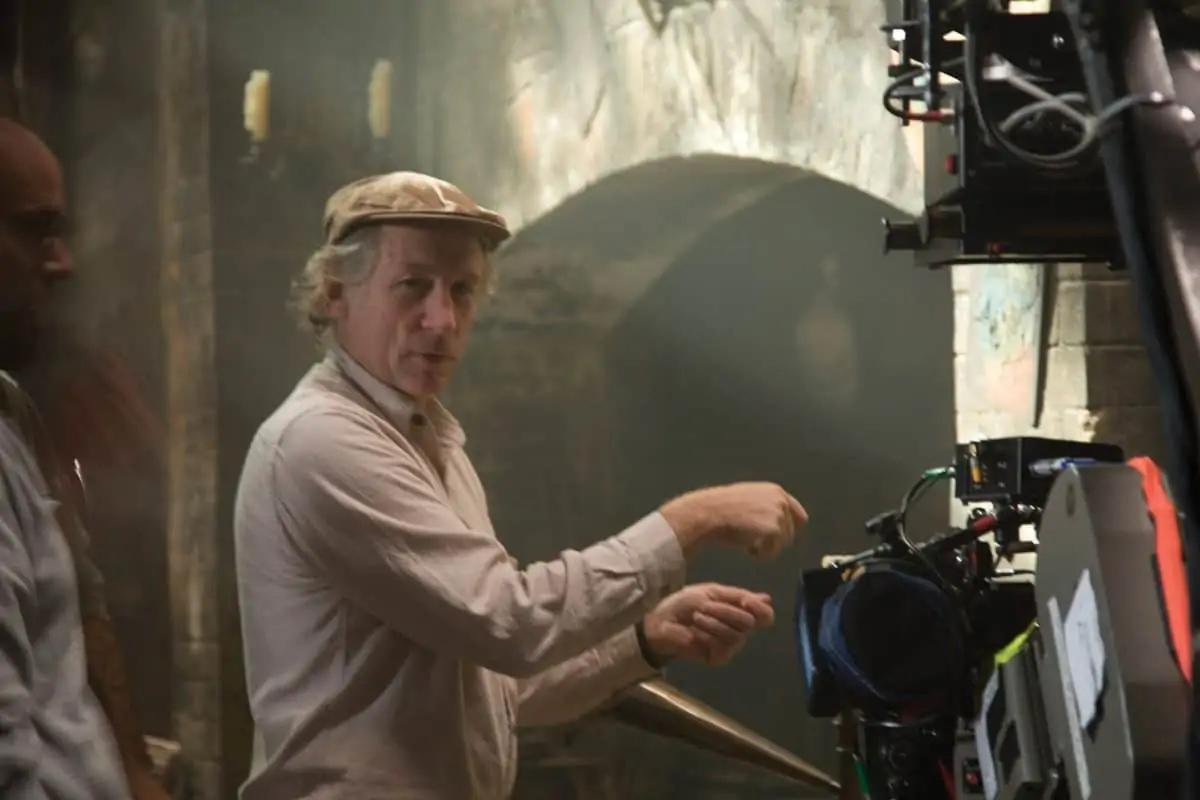GIRL GANG
Cinematographers Oliver Curtis BSC, Laura Bellingham and Matt Wicks on meshing contemporary and period in Apple TV+’s youthful ensemble drama The Buccaneers.
Oliver Curtis BSC hadn’t shot a period drama since he filmed BBC’s Vanity Fair in 1998 (for which he earned a BAFTA nomination). So, when the opportunity came for Apple TV+’s The Buccaneers, his interest was piqued.
Inspired by Pulitzer Prize-winning author Edith Wharton’s unfinished final novel of the same name, the eight-episode series follows a fun-loving gang of young American women who come to shake up the ‘London seasons’ of the 1870s in a sexy Anglo-American culture clash. It stars Kristine Frøseth as Nan St. George and Christina Hendricks plays her mother, Mrs. St. George, along with a youthful ensemble cast.

“[On Vanity Fair] we shot 16 millimetre, 4×3 aspect ratio, no LEDs; all very old-school, and stylistically very Hogarthian, gritty and textural,” says Curtis. “I was keen to revisit period work with a modern approach. This story is a clash of cultures with young American women with new money coming over to Britain to meet aristocratic husbands with old money. The potential was there for visual playfulness – exuberant, expressive characters meeting repressed, insular individuals. [That’s] full of opportunities for a cinematographer.”
Along with the classic Barry Lyndon and his own work on Vanity Fair, one other visual touchstone for Curtis and executive producer and block one director Susanna White – whom he’s worked with previously on FX’s Trust in 2018 – was the irreverence of Sofia Coppola’s Marie Antoinette. Staying away from it as a stylistic reference, they leaned into the no-rules ethos which allowed a contemporary expression even though it depicted a period world.
“I think inherently [in The Buccaneers script] there’s […] a vocabulary and an attitude within them that affects [everything they encounter]. The language of the cinematography had to reflect that – it couldn’t be too static when they’re bustling around and breaking down [social] barriers. We had to respond to that through camera movement, through energy and being playful with how we would frame and compose.
“When the spaces are occupied more by the British characters, there was an opportunity to be more composed, more rigid in our world depiction,” continues Curtis, lauding the work of his A-camera operators Sebastian Barraclough and Alex Brambilla and B-camera operator Laura Dinnett. “It was great to create and destroy, if you will, because that’s what was happening when these two worlds are clashing head on. We didn’t want to stand back and just admire the scenery and elegant rooms; wherever possible we tried to engage with the space and to disrupt expectation.”

Painting a portrait
For Curtis, it was vital to stay central to portraiture in The Buccaneers. What is conveyed through facial expression – setting aside the grand interiors, sweeping vistas, the ballrooms and dining rooms – “the centrality of looks and glances exchanged between characters and the eyes of individuals when alone was of utmost importance to me.”
This was Curtis’s reasoning for filming on the ARRI Alexa LF with ARRI DNA lenses. He spent a lot of time close to the actors and wanted to feel their emotions and see the nuance in performance. Curtis loves the large format sensor for its ability to be relatively close to an actor without distorting their face and still get a good sense of the world around them. For the DNA lenses, which are rehoused vintage glass, he worked closely with Simon Surtees at ARRI Rental to detune their workhorses on the show: the 25, 29, 35 and 40mm.
“For portraiture, I generally work on a large sensor at about 2.8/4 split because I like to keep both eyes relatively sharp,” says Curtis. “I don’t want to shoot wide open because I feel that it’s too soft for a face, but at this stop it falls off nicely. And detuning the DNAs helped to add a variable flavour to the image; I could drop in an ND and shoot a bit wider, and the edges fall off much more dramatically with a nice bokeh in the background. But I always tried to keep that nuanced – felt rather than seen.”
One of Curtis’s trickiest scenes was the debutante ball towards the end of episode one when all the eligible young ladies are presented at the Grosvenor House. With over 150 supporting actors all dressed in white descending a white marble staircase, White and Curtis wanted the feel of a cattle market where men pry and gawk and point – a very voyeuristic scenario. Shooting in the central stairwell of Glasgow City Chambers, there were plenty of challenges: there was very little prep time because it is a working city council building, they weren’t allowed to rig any lights inside (there were chandeliers with electric lightbulbs, but they couldn’t touch them), there was a huge skylight above them, and there were no windows in the corridors surrounding the stairwell at the lower levels.

“All that considered,” says Curtis, “the window plugs worked really well in creating a light and dark chiaroscuro kind of effect on the different areas of the building, and also enhanced the sort of heavenly whiteness, of the marble and women’s dresses.”
The window plugs he refers to are what he thought up in order to fake windows where actually there were just doorways off the staircase leading to other council chamber rooms. So, Curtis asked production designer Amy McGuire to build these window plugs, effectively taking the doors out and building netted curtains in their place with lights behind them to create the illusion of windows along the corridors.
“Amy created a scaffolding rig of drapery and net curtains with candelabras left and right of that,” explains Curtis, “and I had my gaffer, Mark Ritchie, and his best boy Craig McLellan, build diffusion panels behind them backlit with 12 Litestar LED units to create the illusion of soft daylight coming in. The Litestars are lower power, which is great when we’re trying to reduce our carbon footprint wherever we can.”
To deal with the skylight and to manage the vagaries of the Glaswegian weather, Ritchie sent some of his team to the roof with a variety of fabrics – blackout, net, silk, etcetera – so that Curtis could modulate the amount of ambient light coming in. Beneath that, Curtis also placed a couple of Leelium balloons that would give them consistent soft top light to supplement the daylight. As they worked their way down the staircase, the electricians would bring the balloons lower and lower in order to carry that soft top light down through the building.
“The best place to see the staircase was from the gap atrium,” says Curtis. “We had to bring in a jib arm to extend out into the middle of that atrium so that we could do circular moves to bring the young women down the staircase and to look down on the other characters who are looking up at the debutantes. We used a GF16 with a Scorpio 3 axis head suspended out over the atrium. Because of weight restrictions and access issues, we couldn’t bring in a telescopic arm, so calculating the reach was critical in getting the build right for each setup. We had three cameras, one on the crane with a remote head in the centre, and then Alex on Steadicam and Laura on B camera. Incidentally, Laura did the whole series with the other cinematographers, and she was always brilliant at her job.”

Setting the look
Curtis shot episodes one and two with White in Glasgow and Edinburgh, and then passed the baton to Laura Bellingham for three, four and five with director Richard Senior, and Matt Wicks took over for six, seven, and eight with director Charlotte Regan.
“It wasn’t about setting hard and fast rules,” Curtis says of his and White’s approach. “We stuck to the same camera format and lens choices so that the language of the visuals had a certain continuity, but we were not in any way prescriptive about how Laura and Matt should go about shooting their blocks. I think that approach keeps it fresh, keeps the series flowing with different turns and a stylistic evolution, because the story does that anyway.”
When Laura Bellingham arrived in Scotland, Curtis’s block was well underway and she visited set, viewed camera tests and watched daily rushes whilst prepping so that she could maintain consistency even as she explored her own cinematographic aims, which was to capture Nan’s (Frøseth) constantly expanding world. During her episodes there were various large set pieces in multiple period locations: parties, castles, stately homes, a garden hedge maze, a Cinderella ball with dialogue around choreography (the University of Glasgow cloisters served as a sublevel ballroom).

“Each set piece presented its own unique technical challenges,” says Bellingham, known for her work on The Flatshare, Amulet, and The Power. “The goal was to keep the story grounded within the human drama while always growing and wowing with impressive scale. The challenge became to maintain cohesion – a lot of planning went into establishing the world of Tintagel Castle, for example, with the VFX and design teams.”
The scene Senior and Bellingham spent the most time planning was a oner following Christina Hendricks’ character from one end of her New York townhouse (shot at Manderston House in Berwickshire) to the other during a party as she searches for Nan.
“We wanted Goodfellas circa 1870,” says Bellingham. “Choreographing this move required a lot of prep, not least negotiating the camera down a twisting silver-plated staircase and lighting the ballrooms – we went for narrow profile balloons rigged from disguised scaffolding. We looked at various options including a CableCam, but ultimately [camera operator] Matt Fisher ACO and his AR rig was the answer. For safety, we blocked in an invisible cutting point but never used it. It was a huge thrill getting it in one.”

Unravelling relationships
Into the third block – episodes six, seven and eight – Matt Wicks knew he was dealing with storylines that have spent the first third of the series being set and are now starting to unravel. Things get confrontational, friendships are tested, and the gang that was so tight-knit really start to come apart at the seams. “We wanted to reflect that [in the visuals] so we played with shadows a bit more and went a bit more static when we could,” says Wicks, known for his work on the first series of Funny Woman, series two of Vigil, and the film People Just Do Nothing: Big in Japan. “One of the things that Charlotte really likes is a static frame that people occupy rather than the camera trying to contain them too much. She liked movement to follow the action a bit with the Steadicam and handheld, but once we were on a dolly, she just wanted to keep the camera still.
“There’s a scene in particular, which is actually the start of our first episode,” continues Wicks, “where Jinny [Imogen Waterhouse], who has found herself in a really toxic, controlling relationship with Lord Seadown [Barney Fishwick], is in the bath and Seadown is kind of bathing her. I framed it so that only half her face is in the shot and that was kind of us trying to show how she’s split down the middle.”
Apple wanted a very high-key, glossy show, which Wicks strove for, of course. But it was fun to be able to get some more moody, perhaps even gritty, shots into the story to give it some more dimension. “[Curtis] put that in my mind from our first conversations of modern ways to capture the lighting while still keeping it a period piece. There really is a fine line to tread there.”











